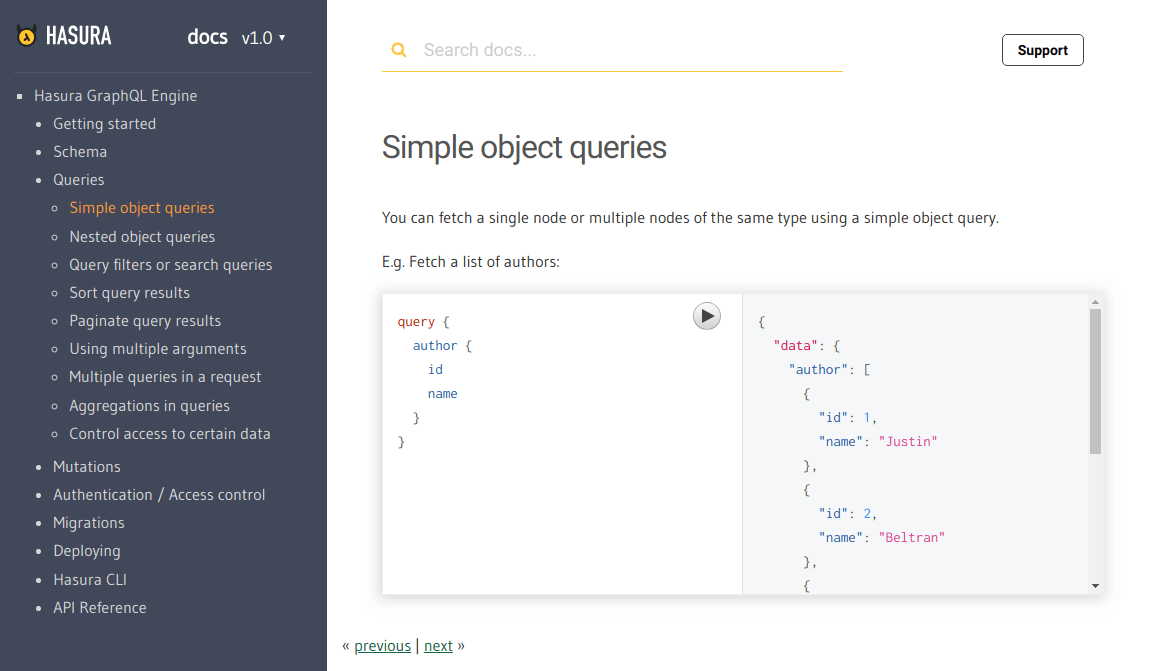This is a GraphiQL plugin for Sphinx that lets you make GraphQL queries from your docs.
We built this for documenting Hasura GraphQL engine's API. Check it out in action here. (Note: In our docs we have added custom css overrides to make GraphiQL look as per our needs)
To insert a GraphiQL component inside your .rst doc, use the declarative:
.. graphiql::
:query:
query {
author {
id
name
}
}If you want to make GraphiQL view-only (ie: disable execution), you just have to add another option :view_only:. For example:
.. graphiql::
:view_only:
:query:
query {
author {
id
name
}
}Sometimes you will want to show the response along with the query without executing it. You can do that by adding a :response: option.
.. graphiql::
:view_only:
:query:
query {
author {
id
name
}
}
:response:
{
"data": {
"author": [
{
"id": 1
"name": "Justin",
},
{
"id": 2
"name": "Beltran",
},
{
"id": 3
"name": "Sidney",
}
]
}
}By default, the GraphQL endpoint is picked up from an environment variable as described here.
In case you want to explicitly set an endpoint for a query, you can do so by adding an :endpoint: option.
.. graphiql::
:endpoint: http://localhost:8080/v1/graphql
:query:
query {
author {
id
name
}
}$ pip install sphinx_graphiqlYou might be using other extensions in your docs. Append sphinx_graphiql to the list of extensions.
extensions.append('sphinx_graphiql')
Add the following tags inside the <head></head> of your template html file (typically layout.html).
<!-- GraphiQL -->
<script src="//cdn.jsdelivr.net/react/15.4.2/react.min.js"></script>
<script src="//cdn.jsdelivr.net/react/15.4.2/react-dom.min.js"></script>
<script src="https://rawgit.com/hasura/sphinx_graphiql/master/static/graphiql/graphiql.min.js"></script>
<link href="https://rawgit.com/hasura/sphinx_graphiql/master/static/graphiql/graphiql.css" rel="stylesheet">
<link href="https://rawgit.com/hasura/sphinx_graphiql/master/static/styles.css" rel="stylesheet">
<script type="text/javascript">
// graphql query fetcher
const graphQLFetcher = function(endpoint) {
endpoint = endpoint || "{{ GRAPHIQL_DEFAULT_ENDPOINT }}";
return function(graphQLParams) {
const params = {
method: 'post',
headers: {
'Accept': 'application/json',
'Content-Type': 'application/json'
},
body: JSON.stringify(graphQLParams),
credentials: 'include'
};
return fetch(endpoint, params)
.then(function (response) {
return response.text();
})
.then(function (responseBody) {
try {
return JSON.parse(responseBody);
} catch (error) {
return responseBody;
}
});
}
};
// create GraphiQL components and embed into HTML
const setupGraphiQL = function() {
if (typeof(React) === 'undefined' || typeof(ReactDOM) === 'undefined' || typeof(GraphiQL) === 'undefined') {
return;
}
const targets = document.getElementsByClassName('graphiql');
for (let i = 0; i < targets.length; i++) {
const target = targets[i];
const endpoint = target.getElementsByClassName("endpoint")[0].innerHTML.trim();
const query = target.getElementsByClassName("query")[0].innerHTML.trim();
const response = target.getElementsByClassName("response")[0].innerHTML.trim();
const graphiQLElement = React.createElement(GraphiQL, {
fetcher: graphQLFetcher(endpoint),
schema: null, // TODO: Pass undefined to fetch schema via introspection
query: query,
response: response
});
ReactDOM.render(graphiQLElement, target);
}
};
// if graphiql elements present, setup graphiql
if (document.getElementsByClassName('graphiql').length > 0) {
setupGraphiQL();
}
</script>You can find these tags at
static/static.htmlof the root directory.
You have to set the GraphQL endpoint as an environment variable in your sphinx configuration file (typically conf.py at the root your your project).
For example:
GRAPHIQL_DEFAULT_ENDPOINT = "https://graphql.my-graphql-app.io/v1/graphql"GraphiQL uses the GraphQL schema to auto complete as you type in queries and mutations.
If your GraphQL endpoint supports introspection, just pass undefined as the schema variable and
auto-completion will work out of the box.
const graphiQLElement = React.createElement(GraphiQL, {
fetcher: graphQLFetcher(endpoint),
schema: undefined, // the schema will be fetched using introspection
query: query,
response: response
});
